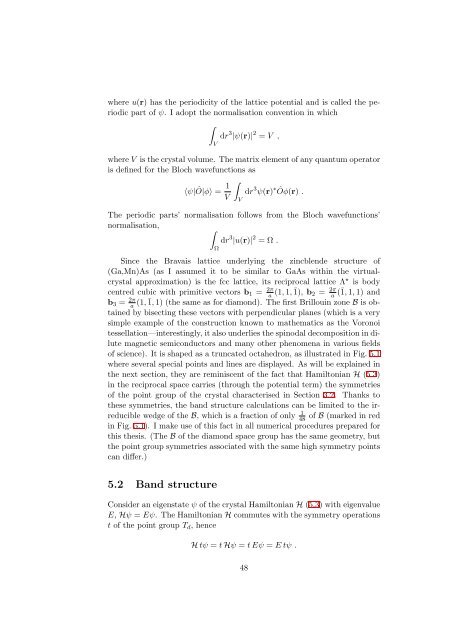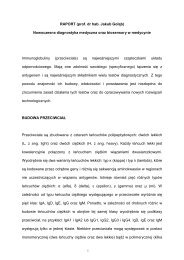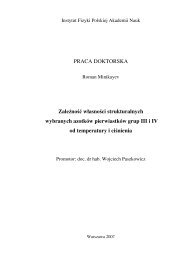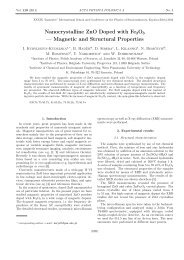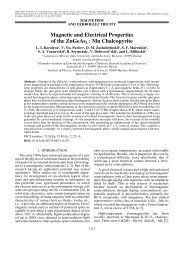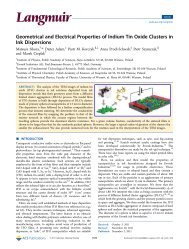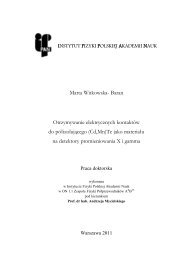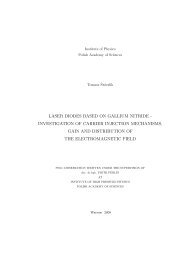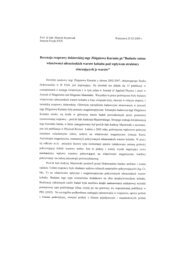Spin waves and the anomalous Hall effect in ferromagnetic (Ga,Mn)As
Spin waves and the anomalous Hall effect in ferromagnetic (Ga,Mn)As
Spin waves and the anomalous Hall effect in ferromagnetic (Ga,Mn)As
You also want an ePaper? Increase the reach of your titles
YUMPU automatically turns print PDFs into web optimized ePapers that Google loves.
where u(r) has <strong>the</strong> periodicity of <strong>the</strong> lattice potential <strong>and</strong> is called <strong>the</strong> periodicpart of ψ. I adopt <strong>the</strong> normalisation convention <strong>in</strong> which∫dr 3 |ψ(r)| 2 = V ,Vwhere V is <strong>the</strong> crystal volume. The matrix element of any quantum operatoris def<strong>in</strong>ed for <strong>the</strong> Bloch wavefunctions as〈ψ|Ô|φ〉 = 1 ∫dr 3 ψ(r) ∗ Ôφ(r) .VVThe periodic parts’ normalisation follows from <strong>the</strong> Bloch wavefunctions’normalisation,∫dr 3 |u(r)| 2 = Ω .ΩS<strong>in</strong>ce <strong>the</strong> Bravais lattice underly<strong>in</strong>g <strong>the</strong> z<strong>in</strong>cblende structure of(<strong>Ga</strong>,<strong>Mn</strong>)<strong>As</strong> (as I assumed it to be similar to <strong>Ga</strong><strong>As</strong> with<strong>in</strong> <strong>the</strong> virtualcrystalapproximation) is <strong>the</strong> fcc lattice, its reciprocal lattice Λ ⋆ is bodycentred cubic with primitive vectors b 1 = 2π a (1,1,¯1), b 2 = 2π a (¯1,1,1) <strong>and</strong>b 3 = 2π a (1,¯1,1) (<strong>the</strong> same as for diamond). The first Brillou<strong>in</strong> zone B is obta<strong>in</strong>edby bisect<strong>in</strong>g <strong>the</strong>se vectors with perpendicular planes (which is a verysimple example of <strong>the</strong> construction known to ma<strong>the</strong>matics as <strong>the</strong> Voronoitessellation—<strong>in</strong>terest<strong>in</strong>gly, italsounderlies<strong>the</strong>sp<strong>in</strong>odaldecomposition<strong>in</strong>dilutemagnetic semiconductors <strong>and</strong> many o<strong>the</strong>r phenomena <strong>in</strong> various fieldsof science). It is shaped as a truncated octahedron, as illustrated <strong>in</strong> Fig. 5.1where several special po<strong>in</strong>ts <strong>and</strong> l<strong>in</strong>es are displayed. <strong>As</strong> will be expla<strong>in</strong>ed <strong>in</strong><strong>the</strong> next section, <strong>the</strong>y are rem<strong>in</strong>iscent of <strong>the</strong> fact that Hamiltonian H (5.3)<strong>in</strong> <strong>the</strong> reciprocal space carries (through <strong>the</strong> potential term) <strong>the</strong> symmetriesof <strong>the</strong> po<strong>in</strong>t group of <strong>the</strong> crystal characterised <strong>in</strong> Section 3.2. Thanks to<strong>the</strong>se symmetries, <strong>the</strong> b<strong>and</strong> structure calculations can be limited to <strong>the</strong> irreduciblewedge of <strong>the</strong> B, which is a fraction of only 1 48of B (marked <strong>in</strong> red<strong>in</strong> Fig. 5.1). I make use of this fact <strong>in</strong> all numerical procedures prepared forthis <strong>the</strong>sis. (The B of <strong>the</strong> diamond space group has <strong>the</strong> same geometry, but<strong>the</strong> po<strong>in</strong>t group symmetries associated with <strong>the</strong> same high symmetry po<strong>in</strong>tscan differ.)5.2 B<strong>and</strong> structureConsider an eigenstate ψ of <strong>the</strong> crystal Hamiltonian H (5.3) with eigenvalueE, Hψ = Eψ. The Hamiltonian H commutes with <strong>the</strong> symmetry operationst of <strong>the</strong> po<strong>in</strong>t group T d , henceHtψ = tHψ = tEψ = Etψ .48


